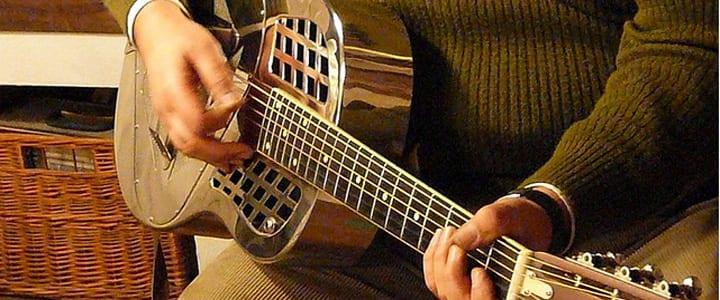If you’re familiar with blues chords and ready to start trying your hand at some riffs, this exercise from guitar teacher Samuel B. will help you get the ball rolling…
Thinking about taking up the blues guitar? Look no further! Here are some fun and easy exercises to get your fingers movin’ and your groove goin’.
Whether you’re a beginner or an experienced player, these exercises will get your creative juices flowing. So grab your guitar and let’s get started!
How Can I Improve My Guitar Blues?
To improve your guitar blues skills, here are some tips:
- A great starting point is to make sure you understand the basics: chord progressions, rhythm techniques and improvisation methods.
- Practice with recordings of established blues guitarists and learn what they do.
- Don’t be afraid of twisting up classic patterns or making subtle changes to some classic blues licks by using visualising techniques such as changing the timings and playing melodies in different octaves.
This type of practice will pay off when it comes to shaping up your original ideas on the fretboard. In short, take your time working on classic blues moves and never be hesitate to use your own creativity.
Need some help getting started? Consider signing up for blues guitar lessons. You’ll learn all the basics, plus helpful tips and strategies like the ones you see in the video below:
https://www.youtube.com/watch?v=1tKEkV7bB1E
What Should I Practice for Blues Guitar?
Learning blues guitar is all about practice, practice, practice. But what should you practice and what are the best blues guitar exercises? We’re here to help! Grab your guitar and get ready to unleash some serious blues power!
Guitar Blues Scale Exercises
The blues scale is essential for any budding blues guitarist. It can be used for single-note riffs or even more complex chords.
Start by playing through the notes of the scale slowly and evenly, then increase your speed as you become more familiar with it.
When you’re feeling confident, try adding some vibrato or bending to your blues scale exercises guitar — these techniques will give your playing an extra bit of soul.
Acoustic Guitar Blues Exercises
If you’re playing on an acoustic guitar, don’t be afraid to get creative! Try fingerpicking some of your favorite blues tunes or improvising over a repeating chord progression. Don’t worry about making mistakes — just have fun and experiment with different sounds and rhythms until you find something that works for you.
Beginner Blues Guitar Exercises for Chords
Chords are essential for any guitar player, so it’s important to spend time learning how to play them correctly. Start by playing basic chords like A, D and E major as well as minor variations like Am7 and Dm7. Then once you’ve mastered those shapes, move on to dominant 7th chords such as A7 and B7. Once you feel comfortable with these shapes, start experimenting with different chord progressions to create your own unique sound.
Basic Blues Guitar Exercises for Mastering Finger Picking
Finger picking is an incredibly useful technique for any guitarist looking to add some complexity to their sound and really bring out the nuances of their music. Start by learning basic fingerpicking patterns such as alternating between two strings or moving up and down the neck while plucking individual notes with each finger in succession.
As you become more comfortable with this technique, try adding hammer-ons and pull-offs into the mix for a truly unique sound!
My Favorite Blues Guitar Exercise
As an instructor (and blues guitar afficionado), I’m keen on you developing a working knowledge of the blues. The blues is the musicological basis of all recognizable forms of American music (gospel, contemporary country, soul, rhythm & blues, bluegrass, early rock n roll, the list goes on). Therefore, said knowledge will improve your fluidity and integrity regardless of whether or not the blues becomes your supreme element.
It’s easy to confuse the form’s structural simplicity (the same three chords in the same order) with a supposed simplicity inherent to blues guitar. First you’ll want to learn first-position chords in the key of E (E, A, and B7 – the most blues-friendly chords in my experience):
E Chord
E|——–|———|
B|——–|———|
G|—O—|———|
D|——–|—-O—|
A|——–|—-O—|
E|——–|———|
A Chord
E|——–|———|
B|——–|—-O—|
G|——–|—-O—|
D|——–|—-O—|
A|——–|———|
E|——–|———|
B7 Chord
E|——–|—-O—|
B|——–|———|
G|——–|—-O—|
D|—O—|———|
A|——–|—-O—|
E|——–|———|
As well, you should practice the blues scale in the key of E (beginning on the 9th fret):
E|——–|—-O—|——–|—-O—|——–|———|—-O—|
B|——–|—-O—|——–|—-O—|——–|———|—-O—|
G|—O—|———|——–|—-O—|——–|—-O—|—-O—|
D|—O—|———|——–|—-O—|——–|—-O—|———|
A|——–|—-O—|——–|—-O—|—O—|—-O—|———|
E|——–|—-O—|——–|—-O—|———|——–|—-O—|
Chords are the basis for rhythm guitar work. Scales are the basis for soloing. These are two completely unrelated elements. The following guitar tab serves as a pedagogical “lubricant” in between them (a trick I learned while being taught Stevie Ray Vaughan’s “Pride And Joy”) and will benefit you regarding both your conditioning and your repertoire:
E|——–|——–|——–|———|——–|———|
B|——–|——–|——–|———|——–|———|
G|——–|——–|——–|———|——–|———|
A|——–|——–|–3,7–|———|–4,6–|———|
E|—0—-|–1,9—|——–|–2,8—|——–|———|
(repeat)
E|——–|——–|——–|———|——–|———|
B|——–|——–|——–|———|——–|———|
G|——–|——–|—5—|———|——–|———|
D|——–|——–|–3,7–|———|–4,6–|———|
A|—0—-|–1,9—|——–|–2,8—|——–|———|
E|——–|——–|——–|———|——–|———|
E|——–|——–|——–|———|——–|———|
B|——–|——–|——–|———|——–|———|
G|——–|——–|——–|———|——–|———|
D|——–|——–|—5—|———|——–|———|
A|——–|——–|–3,7–|———|–4,6–|———|
E|—0—-|–1,9—|——–|–2,8—|——–|———|
If your’re familiar with blues guitar already, then you may have deduced that this sequence aligns with the first two-thirds of the twelve-bar blues chord progression. The remaining one-third (the B7th, A, E descent – one measure per chord) involves one relevant sequence per chord:
E|——–|——–|———|——–|———|
B|——–|——–|———|——–|———|
G|——–|——–|———|——–|———|
D|–0,3—|——–|———|——–|———|
A|–0,1—|—2—|———|——–|———|
E|——–|——–|———|——–|———|
(repeat 3 more times)
E|——–|——–|———|——–|———|
B|——–|——–|———|——–|———|
G|–0,3—|——–|———|——–|———|
D|–0,1—|—2—|———|——–|———|
A|——–|——–|———|——–|———|
E|——–|——–|———|——–|———|
(repeat 2 more times)
E|——–|——–|——–|———|——–|———|——–|
B|——–|——–|——–|———|——–|———|——–|
G|——–|——–|——–|———|——–|———|——–|
D|——–|——–|–0,5—|———|——–|———|——-|
A|——–|–0,3,8-|——–|———|—9—-|-4,10—-|—–|
E|–0,2,7-|——–|——–|–1,6—-|——–|———|——-|
Once you’ve learned to play this sequence smoothly, there are several ways to decorate the sequence. Among them are hammer-ons and pull-offs. As suggested by the name, a hammer-on is a single note altered by way of a left (not right) hand fourth-finger addition:
|——–|—O—-|———|—X—|
In this case, your index finger is “O” and your fourth one is “X.” The string is played only once with the right hand, but augmented with an extra note from the left literally hammered on to the vibrating string. You can also produce hammer-ons on open strings with your third finger:
O |——–|—X—-|———|
Inversely, pull-offs involve your left hand’s fourth finger (or third in the case of open strings) releasing a vibrating note:
|——–|—X—-|———|—O—|
X |——–|—O—-|———|
How Do I Practice Blues Soloing?
Practicing blues soloing is a great way to expand your guitar playing abilities.
The key to successfully mastering the blues is to apply subtleties of expression and technique. Starting off with a simple pentatonic scale can help you play around with melodic ideas that are authentic to the genre.
Once you have become familiar with this, start experimenting with double stops, rhythmic patterns and chromatic approaches, as each of these will give different sounds to your solos.
Make sure to then practice improvising over standard 12-bar blues progressions. By learning how each of these elements fit together, you will be prepared to tackle anything from an unpredictable jam session to a lengthy improvised solo at a gig.
What Are the Best Blues Guitar Exercises to Try?
When it comes to learning how to play blues guitar, there is no single exercise that will lead you down the path towards mastery. However, by engaging in various warmup techniques such as scales, string bends and slides, arpeggios, and fingerpicking exercises you can quickly build up your individual skillset and establish a solid foundation for evolving your own unique style.
Put in the time to practice these exercises regularly and you’ll have a great grasp of the basics of blues guitar in no time!
Play around with these suggestions and see what works for you. You may develop some tricks of your own. As a teenager, I created a unique warping effect by holding down and bending two strings with one finger. Above all, have fun and don’t be afraid to make mistakes!

Samuel B. teaches beginner guitar lessons in Austin, TX. He teaches lessons face-to-face without sheet music, which is his adaptation of Japanese instruction (involving a call-and-response method). Learn more about Samuel here!
Photo by nociveglia
Suzy S.

